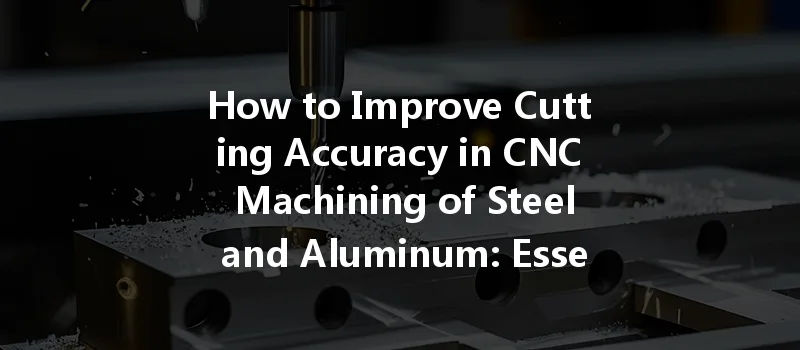*
Welcome to the captivating world of CNC (Computer Numerical Control) machining, where precision meets innovation! At YL Machining, we believe that cutting accuracy is not just a criterion; it’s an art form. The intricate dance of programming, tooling, and material selection has the power to transform raw metal into fine craftsmanship—whether it’s steel or aluminum. In this extensive article, we will delve into the various strategies and techniques to enhance cutting accuracy in CNC machining.
Prepare to explore the depths of technology, share in profound insights, and traverse the realm of machining principles as we guide you through essential tips, methodologies, and innovations that elevate your projects to new heights.
—
Cutting accuracy in CNC machining is paramount for several reasons.
Accurate cutting techniques lead to improved product quality, which can enhance customer satisfaction, a competitive edge, and financial performance for businesses.
—
Understanding the factors that influence cutting accuracy is essential for any machinist or engineer. Here are several critical elements to consider:
2.1 Machine Tool Selection
The foundation of accuracy lies in the CNC machine itself. Factors such as the machine’s rigidity, thermal stability, and the quality of its components play a vital role. Machines with high-quality components lead to consistent, repeatable machining processes.
2.2 Tool Geometry
Tool selection is critical. The geometry of the cutting tool—angle, tip shape, and material—contribute significantly to cutting performance. For instance:
2.3 Workpiece Material
Different materials react differently during cutting processes. Aluminum typically requires different tooling and speeds compared to steel. Factors like hardness, toughness, and thermal properties must be considered to ensure optimal cutting conditions.
2.4 Cutting Parameters
These encompass cutting speed, feed rate, and depth of cut, which are pivotal to achieving the desired accuracy:
2.5 Fixture Stability
Properly clamping the workpiece is crucial for maintaining dimensional integrity. Any movement during machining can lead to inaccuracies.
—
Now that we’ve established the foundational factors that affect cutting accuracy, let’s explore specific strategies to enhance it in CNC machining.

3.1 Calibration and Maintenance
Regular calibration of CNC machines ensures precision in motion and positioning. Maintenance routines should include:
Implementing a preventative maintenance program ensures longevity and accuracy stays constant over time.
3.2 Use of Advanced CAD/CAM Software
Utilizing modern CAD/CAM (Computer-Aided Design/Computer-Aided Manufacturing) software provides more control over the machining process. The software allows for:
3.3 Implementation of Cutting-edge Tooling
Investing in high-quality tooling, such as indexable and coated tools, can significantly improve cutting performance. Tool coatings (such as TiN, TiAlN, or diamond-like carbon) reduce friction, enhance heat resistance, and improve tool life, leading to better accuracy over prolonged use.
3.4 Adaptive Control Systems
Adaptive control systems can be integrated into CNC machining to dynamically adjust parameters based on real-time feedback from the machining process. This can include the correction of feed rates or cutting speeds based on tool wear and workpiece characteristics, thereby enhancing accuracy.
—
As we advance further into the realm of CNC machining, technological innovations continue to emerge that can significantly enhance cutting accuracy.
4.1 Machine Learning and AI
Artificial Intelligence (AI) and machine learning play roles in optimizing the CNC machining process. AI algorithms can analyze extensive datasets from past machining operations to predict optimal settings that enhance accuracy.
4.2 5-Axis Machining
Advancing from traditional 3-axis to 5-axis machining allows greater flexibility and precision in handling complex geometries. This minimizes the need for repositioning the workpiece and ensures tight tolerances in intricate parts.
4.3 In-Process Measurement and Feedback
Implementing in-process measurement technologies (such as laser scanners or touch probes) enables real-time feedback on part quality, supporting immediate adjustments and improving overall accuracy.
—
As we conclude our exploration into enhancing cutting accuracy in CNC machining, we hope to have equipped you with valuable insights and actionable strategies. At YL Machining, we understand that precision is more than just a requirement—it’s a commitment to quality, innovation, and customer satisfaction.
By prioritizing proper machine selection, tool geometry, cutting parameters, and state-of-the-art technologies, you can achieve outstanding results in your projects. Continuous improvement and adaptation to new techniques will ensure your CNC machining operations remain at the forefront of the industry.
We invite you to reach out to YL Machining for all your CNC machining needs. Together, let’s craft precision, embrace innovation, and elevate your manufacturing experience to new heights!
—
—




